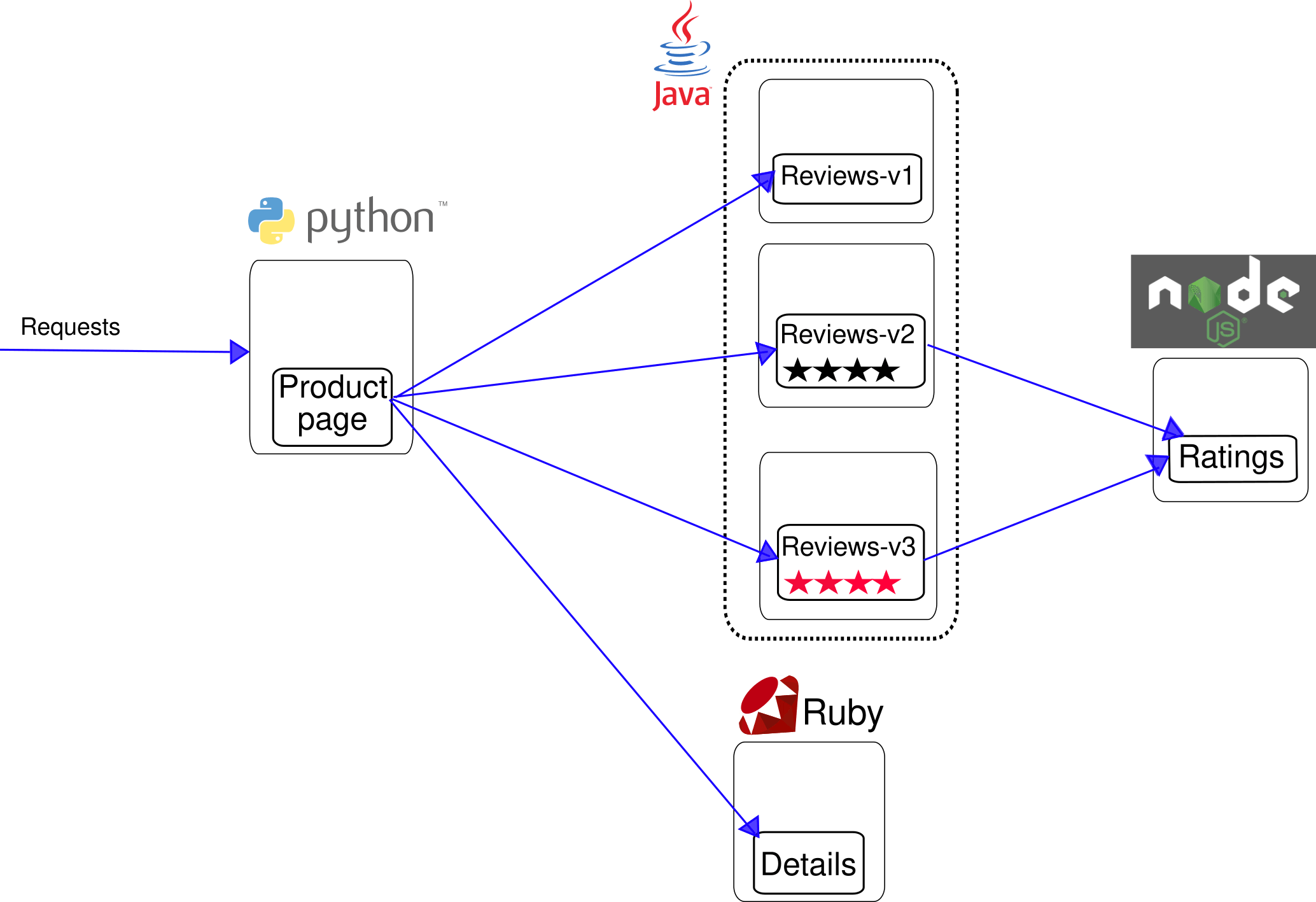Deploy Example Bookinfo Application
To test a second application, a bookinfo application shall be deployed as an example.
The following section finds it’s origin at:
The Bookinfo application displays information about a book, similar to a single catalog entry of an online book store. Displayed on the page is a description of the book, book details (ISBN, number of pages, and other information), and book reviews. The Bookinfo application consists of these microservices: * The productpage microservice calls the details and reviews microservices to populate the page. * The details microservice contains book information. * The reviews microservice contains book reviews. It also calls the ratings microservice. * The ratings microservice contains book ranking information that accompanies a book review. There are three versions of the reviews microservice: * Version v1 does not call the ratings Service. * Version v2 calls the ratings Service and displays each rating as one to five black stars. * Version v3 calls the ratings Service and displays each rating as one to five red stars. The end-to-end architecture of the application is shown below.

To use the bookinfo application inside service mesh, no code changes are required. Instead an Envoy proxy is added as a sidecar container to all containers (product, review, details) which intercepts the traffic.
Installation
Let’s start right away:
Create a new project
oc new-project bookinfoAdd the new project to our Service Mesh
apiVersion: maistra.io/v1 kind: ServiceMeshMember metadata: name: default namespace: bookinfo spec: controlPlaneRef: name: basic-install namespace: istio-systemCreate the application
oc apply -n bookinfo -f https://raw.githubusercontent.com/Maistra/istio/maistra-1.1/samples/bookinfo/platform/kube/bookinfo.yamlCreate the Gateway and the VirtuaService
oc apply -n bookinfo -f https://raw.githubusercontent.com/Maistra/istio/maistra-1.1/samples/bookinfo/networking/bookinfo-gateway.yamlCheck if the services and pods are up and running
oc get svc,pods NAME TYPE CLUSTER-IP EXTERNAL-IP PORT(S) AGE service/details ClusterIP 172.30.178.172 <none> 9080/TCP 7m16s service/productpage ClusterIP 172.30.78.96 <none> 9080/TCP 7m13s service/ratings ClusterIP 172.30.154.12 <none> 9080/TCP 7m15s service/reviews ClusterIP 172.30.138.174 <none> 9080/TCP 7m14s NAME READY STATUS RESTARTS AGE pod/details-v1-d7db4d55b-mwzsk 2/2 Running 0 7m14s pod/productpage-v1-5f598fbbf4-svkbc 2/2 Running 0 7m11s pod/ratings-v1-85957d89d8-v2lrs 2/2 Running 0 7m11s pod/reviews-v1-67d9b4bcc-x6s2v 2/2 Running 0 7m11s pod/reviews-v2-67b465c497-zpz6z 2/2 Running 0 7m11s pod/reviews-v3-7bd659b757-j6rwn 2/2 Running 0 7m11s
Verify that application is accessible
Export the Gateway URL into a variable
export GATEWAY_URL=$(oc -n istio-system get route istio-ingressgateway -o jsonpath='{.spec.host}')Verify if the productpage is accessible
curl -s http://${GATEWAY_URL}/productpage | grep -o "<title>.*</title>" <title>Simple Bookstore App</title>You can also access the Productpage in your browser. When you reload the page several times, you will see different results for the Reviews. This comes due to 3 different versions: one without any rating, one with black stars and one with red stars. http://${GATEWAY_URL}/productpage
 Figure 2. Bookinfo Application
Figure 2. Bookinfo Application
Adding default Destination Rule
oc apply -n bookinfo -f https://raw.githubusercontent.com/Maistra/istio/maistra-1.1/samples/bookinfo/networking/destination-rule-all-mtls.yamlThis will add default routing to all endpoints with same weight. As you can see in Kiali, the Reviews microservice is contacted equally.

Feel free to play with other DestinationRules to controll your traffic.
Copyright © 2020 - 2025 Toni Schmidbauer & Thomas Jungbauer
 Thomas Jungbauer
Thomas Jungbauer
Discussion
Comments are powered by GitHub Discussions. To participate, you'll need a GitHub account.
By loading comments, you agree to GitHub's Privacy Policy. Your data is processed by GitHub, not by this website.